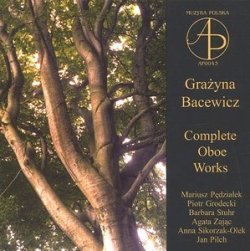Grazyna Bacewicz - Complete Oboe Works (1999)
Grazyna Bacewicz - Complete Oboe Works (1999)

01. Trio voor hobo, harp en slagwerk - moderato generoso [0:06:21.31] 02. Trio voor hobo, harp en slagwerk - andantino melancolico [0:06:00.72] 03. Trio voor hobo, harp en slagwerk - Giocoso [0:05:43.36] 04. Sonatine voor hobo en piano - allegratto [0:02:58.65] 05. Sonatine voor hobo en piano - - Canon (lento) [0:02:35.25] 06. Sonatine voor hobo en piano - Allegro non troppo [0:03:45.18] 07. Sonate voor hobo en piano - allegro ma non troppo [0:05:11.57] 08. Sonate voor hobo en piano - tempo die valse [0:02:33.10] 09. Sonate voor hobo en piano - vivace [0:02:49.56] 10. Trio voor hobo, viool en cello - allegro molto [0:03:53.69] 11. Trio voor hobo, viool en cello - andantino [0:03:41.50] 12. Trio voor hobo, viool en cello - allegretto [0:02:21.40] Mariusz Pedzialek – oboe Piotr Grodecki – piano Barbara Stuhr – violin Agata Zajac – cello Anna Sikorzak-Olek – harp Jan Pilch – percussion
Dating from 1937 and 1955 respectively, the "Sonata" and "Sonatina" are sprightly, fresh works in the French neo-classical vein with syncopated rhythms, ostinato passages and the mixture of the serene and the grotesque which are characteristic of the genre the 1936 "Trio for oboe, violin and piano" has all the insousiance of Poulenc. Coming from the composer's last period (1965), the oboe-harp-percussion trio has much of the spirit of her neo-classical works while having a different sound world, where each instrument searches for coloristic sound possibilities while still remaining very approachable. ---Records International
Acte Préalable continues its excellently-produced series of the works of Bacewicz in this volume of her works for oboe. These pieces are not as immediately accessible as her other works, but, with repeated listening, show themselves to be greatly intricate and well-constructed works.
The first work is a rather unusual piece scored for oboe, harp, and percussion. Composed at about the same time as Incrustations for horn and chamber ensemble (found on Acte Préalable 0044), the arresting slow middle movement quotes the Bacewicz Partita of 1955, also quoted in the Piano Quintet No. 2 of 1965, found on Acte Préalable 0022. With the instruments used, the harp takes on an almost pianistic element, contrasting with the single-line element of the oboe.
The Sonatina shows a far different approach. Though evidently irritated at being referred to as neo-classicist — an appellation that surely would have amused Prokofiev — Bacewicz shows neo-classicist turns with this work. Perhaps it is this baleful glance at classicism that recalls Prokofiev so strongly. Still, this remains a piece that retains a voice that is unmistakably personal to Bacewicz. Though the pieces here have a sarcastic con brio nature, they couldn’t possibly be mistaken for Prokofiev. The second movement of the Sonatina has a distant, frosty nature, detached from the chummy-snide nature of the first movement. The piece ends with a vivacious fast movement that retains some emotional tension while showing an outgoing demeanour. The balance of the movement is weighted more to the piano but provides a thoroughly enjoyable conclusion.
The Sonata, obviously a more serious-minded stab at the oboe/piano repertoire, starts out more conventionally. This makes sense, considering it is the earliest work here by almost thirty years. Evidently not held in such low regard by the composer as the first quartet, composed only a year later in 1938 and not recorded until recently (on Acte Préalable AP0021), it wasn’t officially belittled by the composer. This piece contains moments, joyous, grotesque, and pensive.
The final piece is another early effort; the Trio of 1935 for oboe, violin, and piano. This piece was premiered later in 1935 — with Prokofiev in attendance — in Warsaw. This fits in rather well with that later musical language of the Sonatina of 1955. It opens with a rather folk-like element, complete with cello drone, almost taking on a Saint-Saëns character in the opening movement, yet still retaining that voice so easily recognizable as Bacewicz.
Acte Préalable are to be commended for their great work in presenting the under-valued works of Polish composers and artists to a wider audience. It is my hope that more underrated works will come to light thanks to their diligence. ---David Blomenberg, musicweb-international.com
download (mp3 @224 kbs):
yandex mega mediafire ulozto gett
Last Updated (Saturday, 01 September 2018 20:11)








